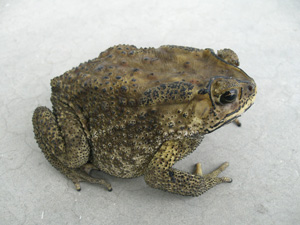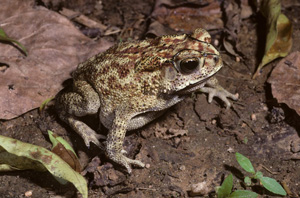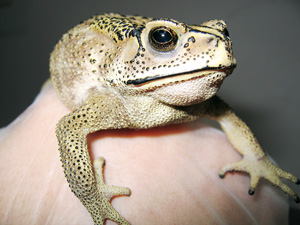Asian black-spined toad
Duttaphrynus melanostictus

Have you seen this animal? Report it now!
Photos and accurate descriptions of where and when the animal(s) was sighted are critical when making a report. Detailed information allows the Victorian government to make a timely and positive identification. All reports are responded to as a priority and may result in trapping, surveillance and the removal of confirmed Asian black-spined toad.
It's important to report Asian black-spined toad sightings
The Asian black-spined toad is not native to Australia and if given the opportunity could establish in the cooler parts of Australia including Victoria. If it became established it could compete with native frogs and toads for food and suitable habitat. As a species entering from overseas it also has the potential to carry exotic parasites and diseases.
Asian black-spined toad are classified as a prohibited pest animal under the Catchment and Land Protection Act 1994. The importation, keeping, breeding and trading of this species, without appropriate permits, is illegal and penalties apply.
The Asian black-spined toad is not known to occur in the wild in Australia. An increasing number are being intercepted at Australian airports and sea ports from flights and ships arriving from Asia, where the toad is widespread. They are usually found in shipping containers, machinery and personal effects such as bags and shoes.
How to identify an Asian black-spined toad

Characteristics of the Asian black-spined toad include:
- raised, black, bony ridges over eyes meeting at the nose
- paratoid gland which excretes poisonous milky substance
- skin colour highly variable, most commonly pale yellow-brown with raised, black warty spots
- skin is dry and rough, not moist and slippery
- short hind limb with pimple-like warts on feet and toes
- white, cream or pale brown underside with black-brown spots
- visible ear drum
- black-tipped, hooked toes
- prominent black rim on upper lip
- distinct, pointy snout.
Size
Asian black-spined toads are a stocky, medium to large toad with a small head and short hind limbs. Adults look very similar to the cane toad, but they do not grow as large.

Colour
Their colour can range from greyish to reddish brown. The most common colour is a pale yellow-brown with dark or reddish-brown streaks and spots.

Distinctive features
Their back is covered with round pimple-like warts, often surrounded by a darker pigment and capped with dark, distinctive spines.
Their head has elevated bony ridges, with long dark crests that border the eyelids and run down on either side of the eye.
They have black tipped, hooked toes.

Habitat
They are habitat generalists that tend to prefer disturbed lowland habitat such as disturbed forest, riparian and human-dominated agricultural and urban areas.
They are nocturnal so shelter during the day under rocks, leaf-litter, logs and man-made structures such as drains, rubbish piles and sometimes houses. At night they often gather beneath street lamps and other lights to catch insects.
Behaviour
They are ground-dwelling, poor climbers and are unable to jump very high due to the absence of large toe pads.
Call
Sounds like a telephone dial tone (creo-o-o, cro-ro-ro-ro) and is sustained for about 30 seconds and repeated in a chorus monotonously. It is very different to most native frog calls. It will be heard at night and sometimes on overcast days.
Similar looking native frogs
Exotic toads such as the Asian black-spined toad are often confused with native frog species and many people have difficulty telling them apart.
In Victoria, many of the exotic toad reports that are received are actually the native Eastern banjo frog, also known as the pobblebonk (Limnodynastes dumerilii).
Before making a report of an exotic toad, use the information in native frog or exotic toad to check the features of the specimen you have sighted and compare the identification characteristics that set native frogs apart from exotic toads.
If still in doubt, email photographs to highrisk.invasiveanimals@agriculture.vic.gov.au or use our online reporting form.
Impact
The Asian black-spined toad has a poison gland much like the cane toad. The toads skin secretions contain several bioactive compounds with lethal, hypotensive, hypertensive, neurotoxic, cardiotoxic, haemolytic and sleep-inducing factors, potentially causing severe impacts for native species which may prey on the toad.
The milky toxin has a pungent odour and may cause itching in the nose and eyes when handled by humans. It does not pose a direct threat to human safety unless directly consumed. The consumption of Asian black-spined toad skin or eggs can cause serious illness or even death.
Image acknowledgement
(i) HAH [CC BY 2.5 (http://creativecommons.org/licenses/by/2.5)], via Wikimedia Commons
(ii) Museum Victoria
(iii) Peter Robinson, Wildlife Profiles
(iv) Australian Government Department of Agriculture
(v) L. Shyamal [CC BY 2.5 (http://creativecommons.org/licenses/by/2.5)], via Wikimedia Commons